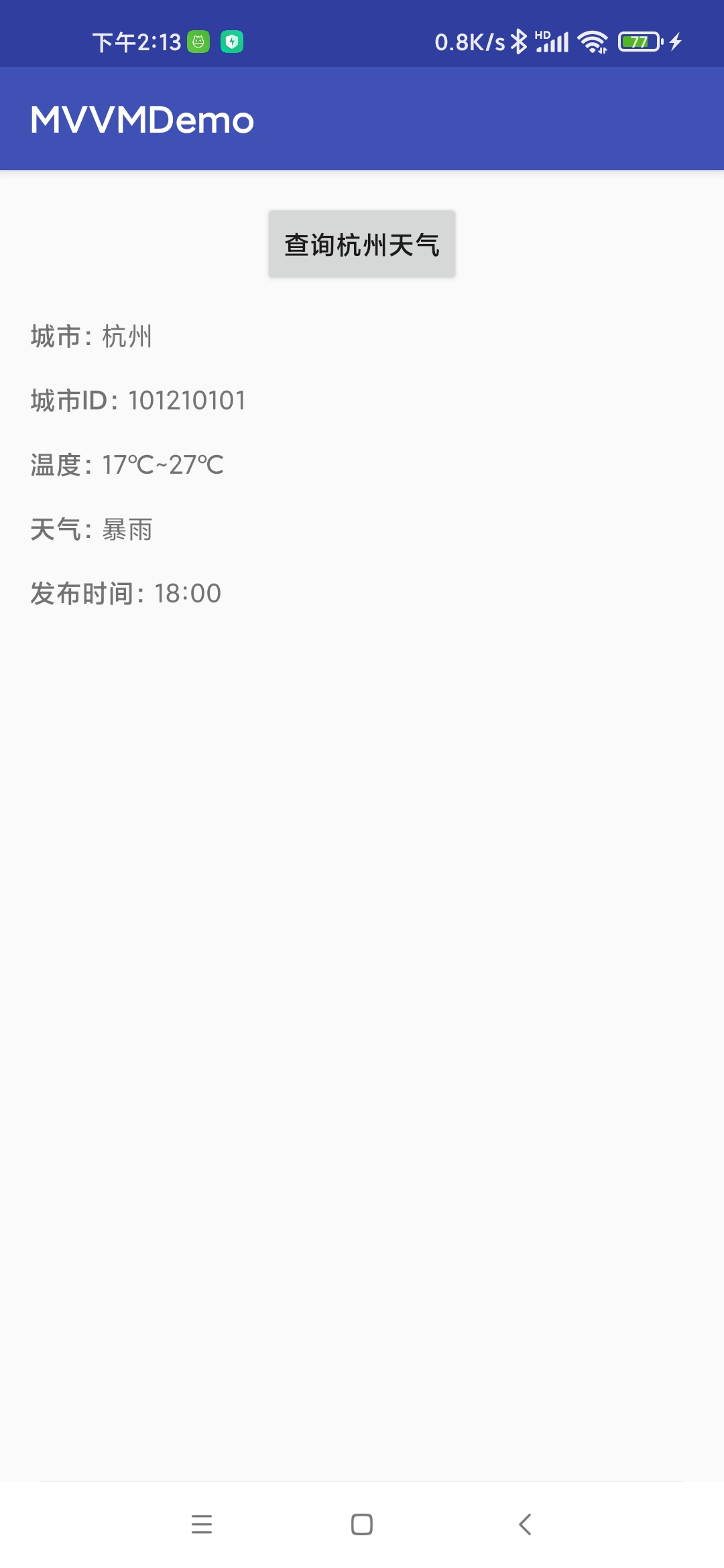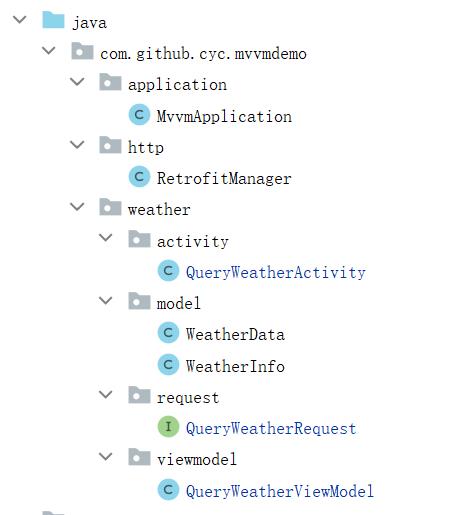Android 用MVVM框架模式+DataBinding+JSON来查询杭州天气信息(更新中)
Posted 彬sir哥
tags:
篇首语:本文由小常识网(cha138.com)小编为大家整理,主要介绍了Android 用MVVM框架模式+DataBinding+JSON来查询杭州天气信息(更新中)相关的知识,希望对你有一定的参考价值。
例子:
下面举一个简单的例子来实践MVVM模式。完整的项目代码下载GitHub上查看: MVVMDemo
例子实现的主要功能是:点击按钮网络查询天气,查询成功后在界面上显示天气信息。主界面如下图所示:

MVVM模式的代码组织结构建议按照业务功能进行划分,具体操作是:每个业务功能独立一个包存放,每个业务功能包下面再按Model、View、ViewModel分包存放。所有的Model存放在model包下面,所有的Activity和Fragment存放在activity包下面。所有的ViewModel存放在viewmodel包下面。该例子比较简单,只有一个weather业务功能模块,最终的代码组织结构如下图所示:

编写Model
查询杭州天气的URL为:
http://www.weather.com.cn/data/cityinfo/101210101.html
访问该URL将返回串JSON字符串,如下所示:
"weatherinfo":
"city":"杭州",
"cityid":"101210101",
"temp1":"5℃",
"temp2":"20℃",
"weather":"晴转多云",
"img1":"n0.gif",
"img2":"d1.gif",
"ptime":"18:00"
按照此JSON字符串,可以编写相应的实体类。WeatherData类的代码如下所示:
public class WeatherData
private WeatherInfo weatherinfo;
public WeatherInfo getWeatherinfo()
return weatherinfo;
public void setWeatherinfo(WeatherInfo weatherinfo)
this.weatherinfo = weatherinfo;
WeatherInfo类的代码如下所示:
public class WeatherInfo
private String city;
private String cityid;
private String temp1;
private String temp2;
private String weather;
private String img1;
private String img2;
private String ptime;
public String getCity()
return city;
public void setCity(String city)
this.city = city;
public String getCityid()
return cityid;
public void setCityid(String cityid)
this.cityid = cityid;
public String getTemp1()
return temp1;
public void setTemp1(String temp1)
this.temp1 = temp1;
public String getTemp2()
return temp2;
public void setTemp2(String temp2)
this.temp2 = temp2;
public String getWeather()
return weather;
public void setWeather(String weather)
this.weather = weather;
public String getImg1()
return img1;
public void setImg1(String img1)
this.img1 = img1;
public String getImg2()
return img2;
public void setImg2(String img2)
this.img2 = img2;
public String getPtime()
return ptime;
public void setPtime(String ptime)
this.ptime = ptime;
编写ViewModel
ViewModel不涉及任何的视图操作,只进行业务逻辑的处理。通过官方提供的Data Binding库,当ViewModel中的数据发生变化时,UI将自动更新。QueryWeatherViewModel的代码如下所示:
public class QueryWeatherViewModel
private static final String TAG = "QueryWeatherViewModel";
public final ObservableBoolean loading = new ObservableBoolean(false);
public final ObservableBoolean loadingSuccess = new ObservableBoolean(false);
public final ObservableBoolean loadingFailure = new ObservableBoolean(false);
public final ObservableField<String> city = new ObservableField<>();
public final ObservableField<String> cityId = new ObservableField<>();
public final ObservableField<String> temp1 = new ObservableField<>();
public final ObservableField<String> temp2 = new ObservableField<>();
public final ObservableField<String> weather = new ObservableField<>();
public final ObservableField<String> time = new ObservableField<>();
private Call<WeatherData> mCall;
public QueryWeatherViewModel()
public void queryWeather()
loading.set(true);
loadingSuccess.set(false);
loadingFailure.set(false);
mCall = RetrofitManager.get()
.create(QueryWeatherRequest.class)
.queryWeather();
mCall.enqueue(new Callback<WeatherData>()
@Override
public void onResponse(Call<WeatherData> call, Response<WeatherData> response)
WeatherInfo weatherInfo = response.body().getWeatherinfo();
city.set(weatherInfo.getCity());
cityId.set(weatherInfo.getCityid());
temp1.set(weatherInfo.getTemp1());
temp2.set(weatherInfo.getTemp2());
weather.set(weatherInfo.getWeather());
time.set(weatherInfo.getPtime());
loading.set(false);
loadingSuccess.set(true);
@Override
public void onFailure(Call<WeatherData> call, Throwable t)
if (call.isCanceled())
Log.i(TAG, "call is canceled.");
else
loading.set(false);
loadingFailure.set(true);
);
public void cancelRequest()
if (mCall != null)
mCall.cancel();
编写View
View不涉及任何的业务逻辑的处理,只进行界面的显示。在xml布局文件中,通过官方提供的Data Binding库,将UI与ViewModel中的数据进行绑定,当ViewModel中的数据发生变化时,UI将自动更新。xml布局文件的代码如下所示:
<?xml version="1.0" encoding="utf-8"?>
<layout xmlns:android="http://schemas.android.com/apk/res/android"
xmlns:tools="http://schemas.android.com/tools">
<data>
<import type="android.view.View" />
<variable
name="viewModel"
type="com.github.cyc.mvvmdemo.weather.viewmodel.QueryWeatherViewModel" />
</data>
<RelativeLayout
android:layout_width="match_parent"
android:layout_height="match_parent"
android:padding="@dimen/default_content_padding"
tools:context="com.github.cyc.mvvmdemo.weather.activity.QueryWeatherActivity">
<Button
android:id="@+id/btn_query_weather"
android:layout_width="wrap_content"
android:layout_height="wrap_content"
android:layout_centerHorizontal="true"
android:text="@string/query_weather"
android:enabled="@viewModel.loading ? false : true"
android:onClick="@() -> viewModel.queryWeather()" />
<RelativeLayout
android:id="@+id/vg_weather_info"
android:layout_width="match_parent"
android:layout_height="wrap_content"
android:layout_below="@id/btn_query_weather"
android:layout_marginTop="@dimen/query_weather_margin"
android:visibility="@viewModel.loadingSuccess ? View.VISIBLE : View.GONE">
<TextView
android:id="@+id/tv_city"
android:layout_width="wrap_content"
android:layout_height="wrap_content"
android:textStyle="bold"
android:text="@string/city" />
<TextView
android:id="@+id/tv_city_value"
android:layout_width="wrap_content"
android:layout_height="wrap_content"
android:layout_toRightOf="@id/tv_city"
android:layout_alignBottom="@id/tv_city"
android:text="@viewModel.city"
tools:text="杭州" />
<TextView
android:id="@+id/tv_city_id"
android:layout_width="wrap_content"
android:layout_height="wrap_content"
android:layout_below="@id/tv_city"
android:layout_marginTop="@dimen/query_weather_margin"
android:textStyle="bold"
android:text="@string/city_id" />
<TextView
android:id="@+id/tv_city_id_value"
android:layout_width="wrap_content"
android:layout_height="wrap_content"
android:layout_toRightOf="@id/tv_city_id"
android:layout_alignBottom="@id/tv_city_id"
android:text="@viewModel.cityId"
tools:text="101210101" />
<TextView
android:id="@+id/tv_temp"
android:layout_width="wrap_content"
android:layout_height="wrap_content"
android:layout_below="@id/tv_city_id"
android:layout_marginTop="@dimen/query_weather_margin"
android:textStyle="bold"
android:text="@string/temperature" />
<TextView
android:id="@+id/tv_temp1_value"
android:layout_width="wrap_content"
android:layout_height="wrap_content"
android:layout_toRightOf="@id/tv_temp"
android:layout_alignBottom="@id/tv_temp"
android:text="@viewModel.temp1"
tools:text="5℃" />
<TextView
android:id="@+id/tv_tilde"
android:layout_width="wrap_content"
android:layout_height="wrap_content"
android:layout_toRightOf="@id/tv_temp1_value"
android:layout_alignBottom="@id/tv_temp"
android:text="@string/tilde" />
<TextView
android:id="@+id/tv_temp2_value"
android:layout_width="wrap_content"
android:layout_height="wrap_content"
android:layout_toRightOf="@id/tv_tilde"
android:layout_alignBottom="@id/tv_temp"
android:text="@viewModel.temp2"
tools:text="10℃" />
<TextView
android:id="@+id/tv_weather"
android:layout_width="wrap_content"
android:layout_height="wrap_content"
android:layout_below="@id/tv_temp"
android:layout_marginTop="@dimen/query_weather_margin"
android:textStyle="bold"
android:text="@string/weather" />
<TextView
android:id="@+id/tv_weather_value"
android:layout_width="wrap_content"
android:layout_height="wrap_content"
android:layout_toRightOf="@id/tv_weather"
android:layout_alignBottom="@id/tv_weather"
android:text="@viewModel.weather"
tools:text="晴" />
<TextView
android:id="@+id/tv_time"
android:layout_width="wrap_content"
android:layout_height="wrap_content"
android:layout_below="@id/tv_weather"
android:layout_marginTop="@dimen/query_weather_margin"
android:textStyle="bold"
android:text="@string/release_time" />
<TextView
android:id="@+id/tv_time_value"
android:layout_width="wrap_content"
android:layout_height="wrap_content"
android:layout_toRightOf="@id/tv_time"
android:layout_alignBottom="@id/tv_time"
android:text="@viewModel.time"
tools:text="10:00" />
</RelativeLayout>
<ProgressBar
android:id="@+id/pb_progress"
android:layout_width="wrap_content"
android:layout_height="wrap_content"
android:layout_centerInParent="true"
android:visibility="@viewModel.loading ? View.VISIBLE : View.GONE" />
<TextView
android:id="@+id/tv_query_failure"
android:layout_width="wrap_content"
android:layout_height="wrap_con以上是关于Android 用MVVM框架模式+DataBinding+JSON来查询杭州天气信息(更新中)的主要内容,如果未能解决你的问题,请参考以下文章